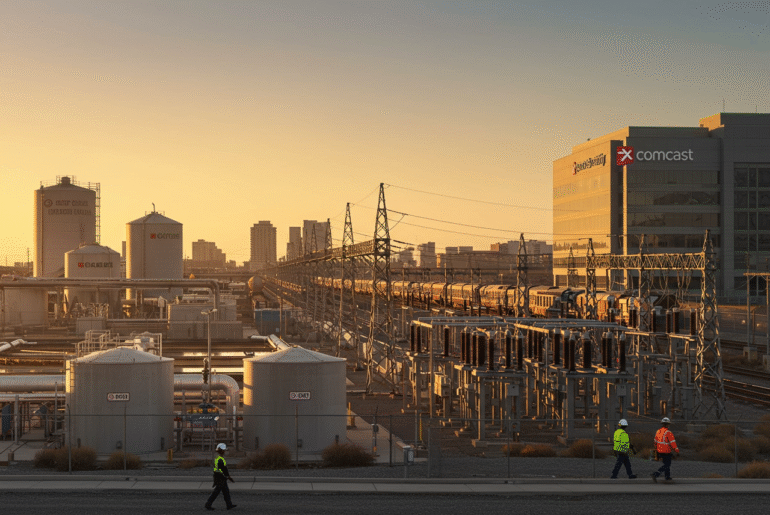This article may contain references to products or services from one or more of our advertisers or partners. We may receive compensation when you click on links to those products or services. Nonetheless, our opinions are our own.
The information presented in this article is accurate to the best of our knowledge at the time of publication. However, information is subject to change, and no guarantees are made about the continued accuracy or completeness of this content after its publication date.
- The Basics of Natural Monopolies
- How Natural Monopolies Form
- Defining Characteristics of a Natural Monopoly
- Market Development Conditions
- Why Economies of Scale Matter
- Entry Barriers for New Competitors
- Examples of Natural Monopolies in the United States
- Takeaways
- Frequently Asked Questions
- What makes a natural monopoly different from a traditional monopoly?
- Why are natural monopolies often regulated by the government?
- Can a natural monopoly ever have competition?
- Are internet service providers considered natural monopolies?
- How do natural monopolies affect consumer prices and choices?
- Recommended Reads
The Basics of Natural Monopolies
Natural monopolies happen when a single provider can deliver services or goods more cost-effectively than multiple providers due to structural market conditions. This often applies to sectors requiring substantial initial investments, such as public utilities and infrastructure.
How Natural Monopolies Form
Natural monopolies form when it is economically logical for one firm to serve the entire market. High fixed costs discourage competition. As production increases, the average cost per unit decreases, making it hard for new firms to enter.
Defining Characteristics of a Natural Monopoly
A natural monopoly arises when a business supplies products more efficiently as a sole provider. Significant startup costs and a need for scale give one provider a long-term advantage. Government regulation often ensures fair pricing and service quality.
Market Development Conditions
Markets that support natural monopolies typically have
- High infrastructure costs
- Economies of scale
- Low marginal production costs
- Regulatory oversight
These conditions allow a single firm to dominate without anti-competitive intent.
Voted "Best Overall Budgeting App" by Forbes and WSJ
Monarch Money helps you budget, track spending, set goals, and plan your financial future—all in one app.
Get 50% OFF your first year with code MONARCHVIP
Why Economies of Scale Matter
Economies of scale are central to how natural monopolies operate. Advantages include:
- High Fixed Costs: Distributed across more output, reducing per-unit costs
- Marginal Cost Reduction: Additional units are cheaper to produce
- Efficient Infrastructure Use: One firm operates the system more cost-effectively
- Broad Customer Base: A large user base lowers individual costs
Entry Barriers for New Competitors
New firms face major obstacles, including
- Large capital investment requirements
- Long-term cost recovery periods
- Market exclusivity arrangements and regulation
These barriers help incumbents maintain market control unless disrupted by policy or innovation.
Examples of Natural Monopolies in the United States
Natural monopolies are common in sectors like energy, water, and transportation. Below are notable U.S. examples.
Electricity Utilities and Power Grids
Electric firms manage costly power lines and stations. A single provider avoids infrastructure duplication, reducing total costs.
| Attribute | Insights |
|---|---|
| Fixed Costs | High upfront investment in transmission infrastructure |
| Market Structure | Single-firm dominance due to lower total costs |
| Allocative Efficiency | Fair pricing achieved through government regulation |
Electric utilities are highly regulated to ensure service reliability and fair pricing.
Water Supply and Distribution Systems
Water systems require significant investment in treatment plants, pipelines, and distribution networks. A single provider can achieve lower per-unit costs but requires oversight to prevent pricing or service issues.
Additional Natural Monopoly Examples
Beyond utilities, some industries function as natural monopolies due to cost and infrastructure demands.
Gas Pipeline Networks
Gas pipeline systems require high capital investment and complex construction. Duplicate pipelines are inefficient, so one provider typically operates in a given area. Pricing is regulated to ensure fair access and reliability.
Public Transportation Infrastructure
Mass transit systems, including subways and commuter rail, require coordinated planning and substantial investment. Centralized management avoids system duplication, but regulatory oversight ensures affordability and accessibility.
Takeaways
- Natural monopolies arise from structural market conditions and economies of scale.
- Utilities such as electricity and water are typical examples.
- High fixed costs and efficiency advantages discourage competition.
- Regulatory oversight ensures fair pricing and service delivery.
- Other sectors, like gas pipelines and public transit, also function as natural monopolies.
Frequently Asked Questions
What makes a natural monopoly different from a traditional monopoly?
A natural monopoly exists due to cost advantages and market conditions. A traditional monopoly results from deliberate efforts to eliminate competition.
Why are natural monopolies often regulated by the government?
To prevent unfair pricing, ensure consistent service, and protect consumers in important markets.
Can a natural monopoly ever have competition?
Rarely. High startup costs and scale advantages deter new entrants, though innovation can occasionally change market dynamics.
Are internet service providers considered natural monopolies?
In some areas, yes, due to high infrastructure costs. However, platform providers like Google are not classified as natural monopolies.
How do natural monopolies affect consumer prices and choices?
They may limit provider options but often result in lower prices due to scale. Regulation helps maintain service quality and affordability.

Reviewed and edited by Albert Fang.
See a typo or want to suggest an edit/revision to the content? Use the contact us form to provide feedback.
At FangWallet, we value editorial integrity and open collaboration in curating quality content for readers to enjoy. Much appreciated for the assist.
Did you like our article and find it insightful? We encourage sharing the article link with family and friends to benefit as well - better yet, sharing on social media. Thank you for the support! 🍉
Article Title: Top Examples of Natural Monopolies in the Real World
https://fangwallet.com/2025/06/21/natural-monopolies-in-the-real-world/The FangWallet Promise
FangWallet is an editorially independent resource - founded on breaking down challenging financial concepts for anyone to understand since 2014. While we adhere to editorial integrity, note that this post may contain references to products from our partners.
The FangWallet promise is always to have your best interest in mind and be transparent and honest about the financial picture.
Become an Insider

Subscribe to get a free daily budget planner printable to help get your money on track!
Make passive money the right way. No spam.
Editorial Disclaimer: The editorial content on this page is not provided by any of the companies mentioned. The opinions expressed here are the author's alone.
The content of this website is for informational purposes only and does not represent investment advice, or an offer or solicitation to buy or sell any security, investment, or product. Investors are encouraged to do their own due diligence, and, if necessary, consult professional advising before making any investment decisions. Investing involves a high degree of risk, and financial losses may occur including the potential loss of principal.
Source Citation References:
+ Inspo
There are no additional citations or references to note for this article at this time.












































